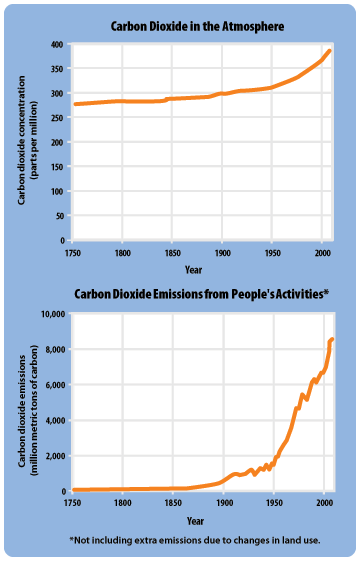Putting the Pieces Together

Source: EPA's Climate Change Indicators (2016) and the Carbon Dioxide Information Analysis Center (2010).

By piecing together the evidence, scientists can say that extra greenhouse gases building up in the atmosphere are the main reason for global climate change. But how do they know where the extra greenhouse gases are coming from?
To find out, let's look at carbon dioxide, the most common greenhouse gas. The top graph shows the actual amount of carbon dioxide in the atmosphere from the year 1750 until today. The bottom graph shows how much extra carbon dioxide people around the world have been putting into the atmosphere since 1750. Can you see the connection?
The amount of carbon dioxide started to increase a few hundred years ago during the Industrial Revolution, when people started burning a lot of fossil fuels like coal, oil, and natural gas for energy. You can also see that people are burning even more fossil fuels today, which explains why the amount of carbon dioxide in the atmosphere has continued to rise.
Other major greenhouse gases, such as methane, nitrous oxide, and fluorinated gases, are increasing in a similar way.
The Missing Pieces
Scientists know a lot about climate change, and they know that the Earth will continue to get warmer as people add more greenhouse gases to the atmosphere. But there's still more to learn.
Here are some of the questions that scientists are still investigating:
What amount of greenhouse gases will be added to the atmosphere?
The amount of greenhouse gases in the atmosphere in the future will depend on the choices people make. For example, if we continue to depend on coal, oil, and natural gas for most of our energy, the amount of greenhouse gases in the atmosphere will continue to increase. If we decide to switch to more renewable energy sources or use less energy through efficiency or conservation, the amount of greenhouse gases could stop rising and eventually decrease.
How warm will the Earth become?
The Earth's climate is very complicated. Even with advanced computer models, we don't know exactly how all of the Earth's different systems will behave and interact with one another as greenhouse gases increase. So scientists give a range of temperature increases that could occur. They predict that:
- If people keep adding greenhouse gases into the atmosphere at the current rate, the average temperature around the world could increase by about 4 to 12°F by the year 2100.
- If we make big changes, like using a lot more renewable resources instead of fossil fuels, the temperature increase will be less—about 2 to 5°F.
Either way, scientists agree that temperatures will increase. They're just not sure by exactly how much, but they are sure that even a 2°F change means that the global climate in the future will be different from today.
How much and how quickly will warmer temperatures lead to other changes?
Scientists know that rising temperatures will cause other changes around the world, and some of these changes have already begun. For example, we know that ice sheets and glaciers are melting, but we don't know exactly how fast or how much more they will melt in the future. But we do know that in general, the more the temperature changes, the more negative the impacts will be. As scientists collect more information, they will be able to make more accurate predictions.
How will climate change affect specific places?
Right now, scientists are better at estimating changes across big areas rather than small areas. For example, they can predict average temperature increases for the whole United States, but they can't say exactly how the temperature might change in your city or town. By collecting more data, scientists are getting better at predicting how climate change will affect specific places.